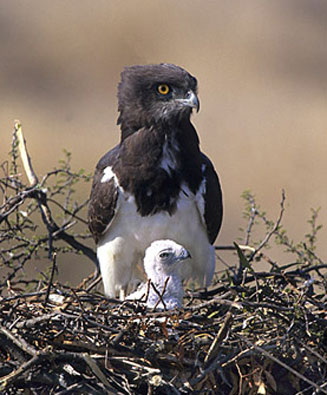|
Circaetus pectoralis (Black-chested
snake-eagle, Black-breasted snake eagle)
Swartborsslangarend [Afrikaans]; uKhozi (generic term for
eagle) [Zulu]; Xithaklongwa [Tsonga]; Circačte ą poitrine noire
[French]; Schwarzbrust-schlangenadler [German];
Įguia-cobreira-de-peito-preto [Portuguese]
Life
> Eukaryotes >
Opisthokonta
> Metazoa (animals) >
Bilateria >
Deuterostomia > Chordata >
Craniata > Vertebrata (vertebrates) > Gnathostomata (jawed
vertebrates) > Teleostomi (teleost fish) > Osteichthyes (bony fish) > Class:
Sarcopterygii (lobe-finned
fish) > Stegocephalia (terrestrial
vertebrates) > Tetrapoda
(four-legged vertebrates) > Reptiliomorpha > Amniota >
Reptilia (reptiles) >
Romeriida > Diapsida > Archosauromorpha > Archosauria >
Dinosauria
(dinosaurs) > Saurischia > Theropoda (bipedal predatory dinosaurs) >
Coelurosauria > Maniraptora > Aves
(birds) > Order: Falconiformes
> Family: Accipitridae
> Genus: Circaetus
Distribution and habitat
Occurs from Ethiopia and
southern DRC to South Africa. In southern Africa it is uncommon to
locally common across much of the region, largely excluding southern and central
South Africa. It occupies a variety of habitats, ranging from semi desert and open
grassland to Karoo scrub and closed deciduous woodland.
|
 |
|
Distribution of Black-chested snake-eagle in
southern Africa, based on statistical smoothing of the records from
first SA Bird Atlas Project (©
Animal Demography unit, University of
Cape Town; smoothing by Birgit Erni and Francesca Little). Colours range
from dark blue (most common) through to yellow (least common).
See here for the latest distribution
from the SABAP2. |
Movements and migrations
Mainly nomadic, although it may make regular
movements to
Namibia and the Northern Cape in summer.
Food
It mainly eats snakes, soaring or hovering while scanning
the ground for prey. It then descends in stages, until it
finally plunges feet first onto the prey, to crush its skull. A snake may fight back
if the snake-eagle misses, entwining itself with the bird, which
occasionally results in the death of both snake and raptor. The following food
items have been recorded in its diet:
- Vertebrates
- reptiles
- frogs
- fish
-
rodents
- birds (rarely)
- Invertebrates
Breeding
- Probably a monogamous, territorial solitary nester.
- The nest (see image below) is built by both sexes, consisting of a
saucer-shaped structure of sticks, lined with green leaves and placed in the
canopy of a flat-topped Acacia or large Euphorbia; it is often
well-concealed by foliage or mistletoe. It may also utilise a pylon or utility
pole, rarely using the same nest in multiple breeding seasons.
 |
|
|
Black-chested snake-eagle nest with chick,
Nylsvley area, South Africa. [photo
Warwick Tarboton ©] |
|
- Egg-laying season in South Africa is from June-August, while elsewhere
in southern Africa it is from March-October, peaking from June-October.
- It almost invariably lays a single egg, which is mainly incubated by the
female for about 51-52 days.
- The chick is brooded and fed by the female, with food provided by the
male. Parental care is most intense in the first 25 days of the chick's life, after
which the adults visit the nest more intermittently. It eventually leaves the nest at about 90-113 days old, usually
becoming fully independent six months later, although in rare cases it can
stay with its parents for roughly 18 months after fledging.
Threats
Not threatened.
References
-
Hockey PAR, Dean WRJ and Ryan PG 2005. Roberts - Birds of
southern Africa, VIIth ed. The Trustees of the John Voelcker Bird Book
Fund, Cape Town.
|
